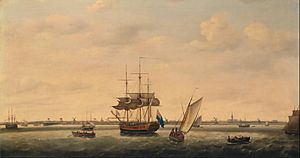HMS Surprise (1774) facts for kids

Surprise
|
|
Quick facts for kids History |
|
|---|---|
| Name | HMS Surprise |
| Ordered | January 1771 |
| Builder | Woolwich Dockyard |
| Laid down | 5 September 1771 |
| Launched | 13 April 1774 |
| Completed | 15 April 1775 |
| Commissioned | February 1775 |
| Fate | Sold for breaking up, 24 April 1783 |
| General characteristics | |
| Class and type | 28-gun Enterprise-class sixth-rate frigate |
| Tons burthen | 593 89⁄94 (bm) |
| Length |
|
| Beam | 33 ft 6 in (10.2 m) |
| Depth of hold | 11 ft 0 in (3.4 m) |
| Sail plan | Full-rigged ship |
| Complement | 200 officers and men |
| Armament |
|
Contents
HMS Surprise (sometimes spelled Surprize) was a fast sailing ship called a frigate. It had 28 guns and was part of the Royal Navy, Britain's navy. The Surprise served during the American Revolutionary War and was taken apart in 1783.
Service History
Building the Surprise
The Surprise was one of five ships ordered because of a disagreement between Britain and Spain. This argument was about who owned the Falkland Islands in 1770. The ship's design was created by Sir John Williams.
Work on the Surprise began on September 5, 1771, at Woolwich Dockyard. It was launched on April 13, 1774. The ship officially joined the navy in February 1775, led by Captain Robert Linzee. It was fully ready for service by April 15, 1775.
Early Voyages and Captures
On May 23, 1775, Captain Linzee sailed the Surprise to Newfoundland. The next year, on March 20, 1776, the Surprise and another ship, HMS Martin, left Plymouth. They were carrying supplies and soldiers to help Quebec, which was under attack by American forces.
The ships met up with HMS Isis on May 3 in the St. Lawrence River. The three ships landed their soldiers on May 6, and the Americans began to retreat. The Surprise and Martin then sailed further up the river to chase the retreating American troops. They captured an American schooner (a type of sailing ship) that had ten guns. They also got back a British navy ship, HMS Gaspée, which the Americans had captured earlier.
The Surprise stayed in North America, based in Newfoundland. During this time, it captured two American ships: the schooner Favourite on May 3, 1777, and the brig Live Oak on September 4, 1777.
Capturing French Islands
In September 1778, France joined forces with the Americans. Because of this, Vice-Admiral John Montagu, who was in charge at Newfoundland, sent a group of ships to capture the French islands of Saint Pierre and Miquelon.
The group included HMS Pallas, Surprise, HMS Romney, HMS Martin, and HMS Bonavista. They also had 200 Royal Marines and artillery. They landed on September 16 and took control of the islands. They also captured two French ships, the Charming Nancy and the Aimable Betsey, on September 18.
Soon after, the Surprise captured a privateer (a privately owned ship allowed to attack enemy ships) named Harlequin off Labrador. This ship was from Salem and had ten small guns. On December 16, the Surprise also captured a French ship called Les Deux Freres.
More Captures in 1779-1782
In February 1779, Samuel Reeve became the new commander of the Surprise. On April 30, the ship sailed back to Newfoundland. There, it captured several more ships:
- On July 16, 1779, the Surprise captured the 12-gun brig Wildcat. This ship had just captured a British schooner called HMS Egmont. The Surprise was able to rescue some British sailors who were on the Wildcat.
- In early October 1779, two American privateers were brought into St. John's. These were the 20-gun ship Jason (captured on October 1) and the 14-gun brig Monmouth (captured on October 5).
- On January 29, 1780, the Surprise captured the 20-gun French privateer Duguay-Trouin near Dodman Point. This ship was later added to the Royal Navy.
- On October 6, 1780, working with HMS Vestal, the Surprise captured the brig Fair American.
- On July 15, 1781, it recaptured a ship called Margaret Christiana.
- On September 3, 1781, the Surprise and HMS Danae arrived at St. John's. They had guided a group of transport and merchant ships to Halifax, Nova Scotia. Along the way, they captured three American privateers: the 16-gun Venus and Independence, and the 10-gun brig Diana. They also retook the ship Lockhart Ross, which two French frigates had captured a few days earlier.
- On September 27, 1781, the brig Sturdy was captured.
- On October 4, 1781, the 14-gun Tiger was captured.
- On January 9, 1782, the Surprise captured Les Sept Freres.
James Ferguson took command of the Surprise on March 2, 1782. He sailed to Newfoundland, protecting a group of ships. On August 16, 1782, the Surprise and HMS Assistance captured the American privateer Raven.
Fate
The Surprise was taken out of service in February 1783. It was then sold on April 24 to be broken up for parts.



